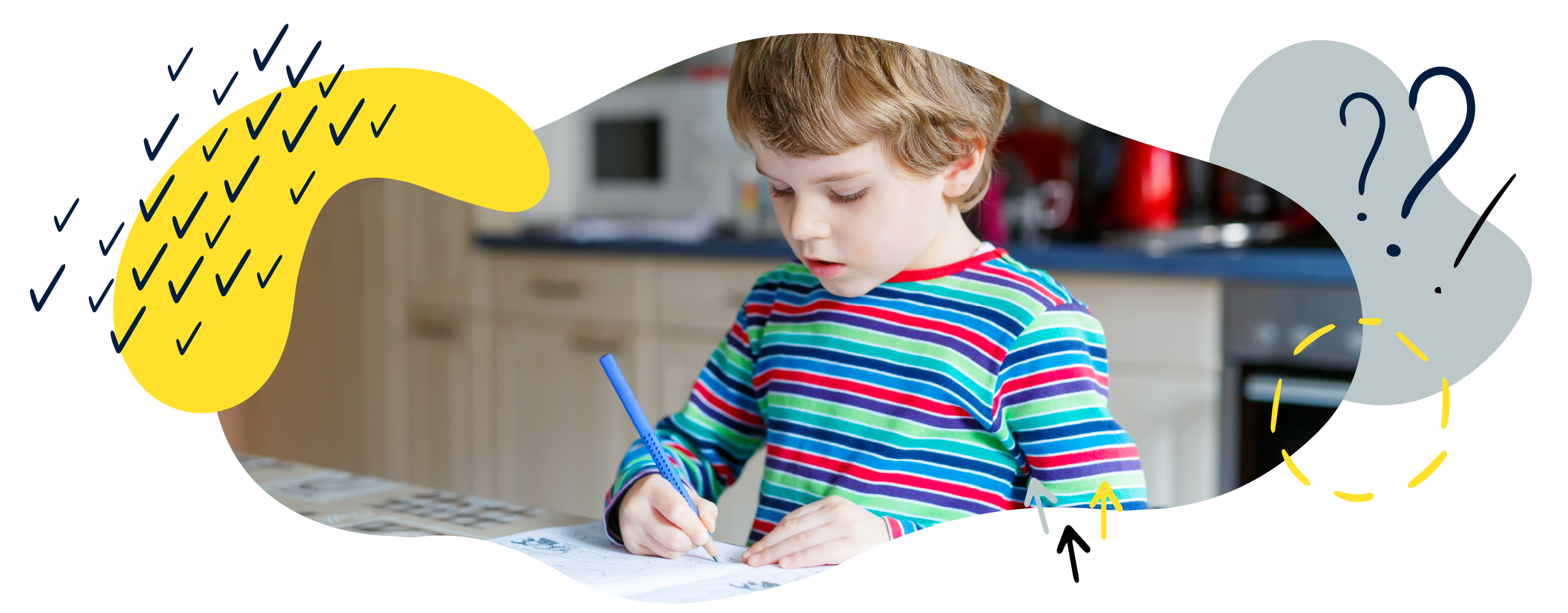

Writing in Year 5 (age 9–10)
In Year 5, your child will continue to develop develop as a writer, becoming more independent and creative. Read on to discover the National Curriculum expectations for writing in Year 5, and to find out how you can support your child at home
How to help at home
There are lots of ways you can help your Year 5 child with writing. Here are our top ideas.
1. Read to your child
While children do learn new language and ideas from speaking and listening, the type of language we use in writing is often very different from that in speech. Reading regularly to your child, especially longer chapter books that they might not be able to yet read independently, is a great way to support their writing.
When you are reading together, look at how authors use different techniques for effect. For example, how do they show excitement or build a sense of tension? How do they make use of interesting language, such as metaphors or similes?
For books to read with your child, take a look at our free eBook library .
2. Have your child to read to you
Even though your child may be able to read independently now, making time to hear them read is great for their reading development. Also, by frequently seeing words in print, they will be able to see how different words (and the punctuation and grammar that join them) are used to share meaning.
When you read, occasionally look at the punctuation and talk about what it is telling the reader to do. Show your child how a question mark tells you to raise your voice at the end of the sentence to indicate a question being asked.
Explore how you can show the ‘feeling’ behind an exclamation mark. Are the characters shouting? Has something unexpected happened? Has something gone wrong?
3. Try some real-world writing
Writing at home can be a great way of practising writing, including using grammar and punctuation to create particular effects. Here are some ideas to encourage regular writing:
- Create a story about a space adventurer with strange planetary systems to explore. Every week or month, your child could write about a new chapter about a different planet. Before long, the chapters will have built into a book they can be really proud of.
- Write an A-to-Z. It could be based on anything your child is interested in – animals, space, dinosaurs, fairies, even their favourite TV programme. A page for each letter of the alphabet gives you 26 short pieces of writing spread over the year that build into one big project.
- Produce a version of a book for a younger child. For example, they could write The Rhino Who Came to Tea or The Very Hungry Angler Fish . Books with a distinctive format such as The Day the Crayons Quit or The Last Polar Bears are perfect for this.
- Write the book of a film or TV programme. If children have watched something they’ve really enjoyed, they could try and tell the same story in writing. Watching the story on screen can give them a useful frame to hang their own writing on.
- While writing using a pen and pencil is useful practice, writing on the computer counts too. You might want to turn the spelling and grammar check off to help children to learn to confidently use their own knowledge. The grammar check can be wrong, too, so this can be confusing for children.
4. Tell stories aloud
Giving your child the opportunity to tell stories orally is a great way to get them used to structuring their ideas and using adventurous language. If they’re not sure where to start, see if they can retell a story that they already know well. Our Traditional tale titles activity sheet has some fun ideas for retelling old stories.
Activity: Story mountain
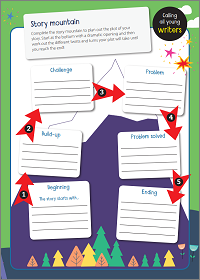
Activity: Perform a poem
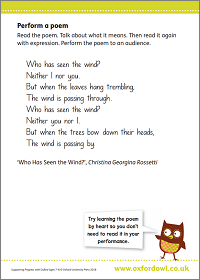
Read the poem, talk about what it means, and perform it to an audience.
5. Find story inspiration
You can find fun story ideas anywhere! Why not raid your kitchen cupboards or hunt through the attic to find lost treasures? Anything from an old hat to a telescope will do the trick. What could the object be used for? Who might be looking for it? What secrets could it hold? Suggest different genres such as mystery or science fiction and discuss how the item might be used in this kind of story.
Real-world facts can also be a great source of inspiration. For example, did you know a jumping flea can accelerate faster than a space rocket taking off into orbit? What crazy story can your child make out of this fact? Newspapers and news websites can be great for finding these sorts of ideas.
For more storytelling ideas, download our free Story idea generator or our Character profile activity sheet .
Activity: Story idea generator
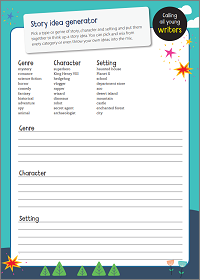
Activity: Character profile
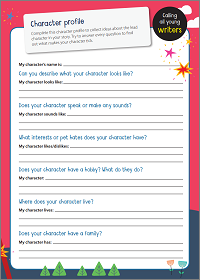
6. Draw your ideas first
If your child isn’t sure where to start with a story or even a piece of non-fiction, it can sometimes be helpful to sketch out their ideas first. For instance, can they draw a picture of a dastardly villain or a brave hero? How about a scary woodland or an enchanted castle?
Your child might also find it useful to draw maps or diagrams. What are all the different areas of their fantasy landscape called? How is the baddie’s base organised?
Some children might enjoy taking this idea a step further and drawing their own comics. This is great practice – it stretches your child’s creativity, gets them thinking about plot, character, and dialogue, and is a big confidence boost once they’ve finished and have an amazing story to look back on.
What your child will learn
In Year 5 (age 9–10), your child will work towards being able to:
- Identifying the audience for and purpose of the writing
- Noting and developing initial ideas, drawing on reading and research where necessary.
- Selecting appropriate grammar and vocabulary, understanding how such choices can change and enhance meaning
- In narratives, describing settings, characters and atmosphere and integrating dialogue to convey character and advance the action
- Using a wide range of devices to build cohesion within and across paragraphs
- Using further organisational and presentational devices to structure text and to guide the reader (for example, headings, bullet points , and underlining).
- assessing the effectiveness of their own and others’ writing
- proposing changes to vocabulary, grammar and punctuation to enhance effects and clarify meaning
- ensuring the consistent and correct use of tense throughout a piece of writing
- ensuring correct subject and verb agreement when using singular and plural , distinguishing between the language of speech and writing and choosing the appropriate register.
- Proof-read for spelling and punctuation errors.
Handwriting, spelling, grammar, and punctuation are all important aspects of writing too. You can find out more about them on our dedicated pages:

Handwriting in Year 5 (age 9-10)
Find out more about handwriting in Year 5 at Primary School.
Find out more

Spelling in Year 5 (age 9-10)
Find out more about spelling in Year 5 at Primary School.
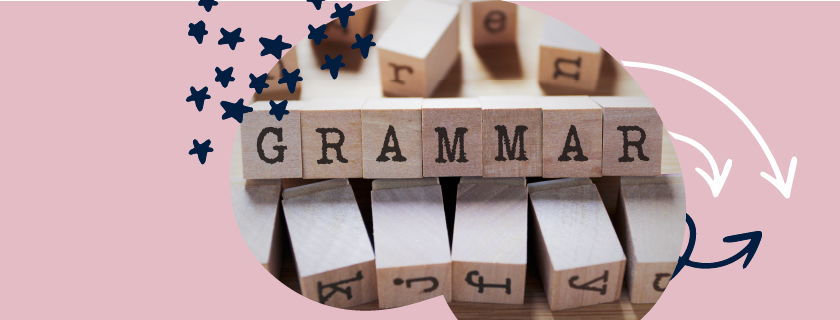
Grammar and punctuation in Year 5 (age 9-10)
Find out more about grammar and punctuation in Year 5 at Primary School.
- Age 5–6 (Year 1)
- Age 6–7 (Year 2)
- Age 7–8 (Year 3)
- Age 8–9 (Year 4)
- Age 9–10 (Year 5)
- Age 10–11 (Year 6)
- Year 1 (age 5–6)
- Year 2 (age 6–7)
- Year 3 (age 7–8)
- Year 4 (age 8–9)
- Year 5 (age 9–10)
- Year 6 (age 10–11)
- Grammar glossary
- Grammar books
Popular searches in the last week:
Year 5 english, choose the block you wish to teach.
Try our FREE Grammar and Punctuation Powerpoints .
Autumn Blocks
Through Chris Riddell’s Goth Girl , explore how atmosphere, settings & characters are created. Study adverbs of possibility, commas, relative clauses, dialogue punctuation.

Gothic Fiction: Goth Girl
Three amazing texts stimulate children’s reading, writing and discussion of first animal, then human, migration. Writing cohesively and using parentheses form the SPaG element, but children’s own creative work will make this block truly exciting.

Reports and Recounts: Migration
Explore the charm and challenge of classic fiction with Rudyard Kipling's Jungle Book and Just So Stories . Study dialogue punctuation, relative clauses and commas.

Classic Fiction: Stories by Rudyard Kipling
Explore instructions and explanations with hover boards, doggie umbrellas & new-fangled escalators. Study the grammar of cohesion and create guides for futuristic travel.

Instructions and Explanations: Changing Technology
Using The Hole , by Oyvind Torseter, children ask and answer questions and use inference skills to speculate about events. Children write their own version or a sequel based on the book.

Modern Fiction: The Hole by Øyvind Torster
Explore exciting destinations through a range of travel writing. Revise pronouns, learn about relative clauses & punctuation, including uses of commas. Write own travel recount.

Blogs and Reports: Travel Writing
Lewis Carroll's Walrus and the Carpenter and Hilaire Belloc's Cautionary Tales stimulate performance, debate, persuasive writing and poetry writing. Revise adverbs and modal verbs.

Classic Poems: Narrative Poems
Word classes, noun phrases, fronted adverbials and paragraphs are taught within the context of writing recounts and newspaper reports about UFO accounts.

Recounts: UFOs and Aliens
The What Do You Do with an Idea story and Save-the-Children’s global children’s poem stimulate art, drama, writing. Humorous poems reflecting lockdown experiences help children explore their own.

Wellbeing: Ideas, weird and wonderful!
Spring blocks.
Study genre of short stories using Short! by Crossley-Holland. Investigate adverbials and develop use of perfect form to indicate time/cause. Write predictions and short stories.

Short Stories: Spooky Short Stories
Look at remarkable facts, common beliefs and reference texts. Learn whether you should believe – or not! Study modal verbs/adverbs and relative clauses.

Information Texts: Reference Texts
Read and write stories set in faraway places using Cloud Tea Monkeys and Mysterious Traveller . Study relative clauses and expanded noun phrases for concise writing.

Stories on a Theme: Faraway Places
Use Tuesday by David Wiesner to study reports. Write speech, playscripts, speech bubbles, direct and reported speech. Use modal verbs; learn about cohesion. Write newspaper reports.

Recounts: Reports and Journalism
Choose from Romeo & Juliet, The Tempest, Macbeth for an in-depth study. Relative clauses & prefixes/suffixes in context of Shakespeare’s new words. Write and perform playscripts. Also in Y6 Autumn.

Classic Plays: Shakespeare
School uniform, detentions, mobile phones or screen time - there’s always an argument! This block lays the groundwork for effective argument and persuasion, written and spoken. Plus grammar: cohesion, paragraphs, commas.

Argument and Debate: Argument and Debate
Summer blocks.
Inspirational short stories from Shaun Tan, guaranteed to stimulate amazing work. Explore use of modal verbs, parenthesis and dialogue. Write a short story in Shaun Tan-style.

Fantasy: Fantasy Stories by Shaun Tan
Explore persuasive letters, adverts, protest songs and speeches. Study the impact of modal verbs and cohesion through adverbs and conjunctions. Deliver persuasive speeches.

Persuasive Writing: Persuasion and Argument
Michael Morpurgo's Kensuke's Kingdom provides inspiration for developing higher level language skills and for cohesion within and between paragraphs, modal verbs/adverbs and commas.

Modern Fiction: Kensuke's Kingdom
Research information about video games and board games. Examine the features of reports before writing your own. Learn how cohesive devices and parenthesis can be used to improve your report writing.

Reports: Games
Become immersed in the world of The Hobbit , investigating settings, characters and narrative style. Write a 'Lost Tale'. Study relative clauses and expanded noun phrases.

Classic Fiction: The Hobbit
Delve into letter-writing, revising conventions, purpose, and register, and analyse fascinating historical texts. Write fan letters, tactful RSVPs and job applications. Study modal verbs, commas, colons and bullet points.

Letters: Historical and Modern Letters
Listen to a variety of inspirational songs, from Blue Moon to A Wonderful World and explore change through historical protest songs. Paint the moon, make friendship bracelets, create tissue-paper art and identify favourite songs.


Wellbeing: Wonderful World
Two weeks’ work, focussed on key skills, NO printing required – all do-able by children at home with just a screen. Starts with a fun day; all you need if your class is self-isolating.

Local Lockdown: 2 week lockdown pack
Code-Breakers is a synthetic phonics programme that teaches phoneme-to-grapheme correspondences (PGCs) in a systematic, child-friendly fashion.
Many Hamilton units come with interactive Grammar Presentations integrated into the overall teaching and textual context. Alternatively, these presentations can be used as stand-alone whiteboard sessions. Try your year group below.
Group Readers are charmingly illustrated short books written to facilitate reading and comprehension progression from Reception right through to Year 6.
This site uses cookies to give you the most relevant information. Learn more
Log in or sign up to get access to this resource
School subscription, reduce teacher workload.
From £155 (+ VAT) per year. Access to all key stages for multiple users.
Individual Subscription
For inspirational teaching.
Just £45 (£37.50 + VAT) per year to get access to all resources.
Early Career Teacher
Develop your teaching.
Just £33 (£27.50 + VAT) to get access to all resources for 2 years.
Taster Account
100s of resources.
Register to access all free resources.
Already subscribed?
Log in to get access.
You are using an outdated browser. Please upgrade your browser to improve your experience.
How to Teach Creative Writing | 7 Steps to Get Students Wordsmithing

“I don’t have any ideas!”
“I can’t think of anything!”
While we see creative writing as a world of limitless imagination, our students often see an overwhelming desert of “no idea.”
But when you teach creative writing effectively, you’ll notice that every student is brimming over with ideas that just have to get out.
So what does teaching creative writing effectively look like?
We’ve outlined a seven-step method that will scaffold your students through each phase of the creative process from idea generation through to final edits.
7. Create inspiring and original prompts
Use the following formats to generate prompts that get students inspired:
- personal memories (“Write about a person who taught you an important lesson”)
- imaginative scenarios
- prompts based on a familiar mentor text (e.g. “Write an alternative ending to your favorite book”). These are especially useful for giving struggling students an easy starting point.
- lead-in sentences (“I looked in the mirror and I couldn’t believe my eyes. Somehow overnight I…”).
- fascinating or thought-provoking images with a directive (“Who do you think lives in this mountain cabin? Tell their story”).

Don’t have the time or stuck for ideas? Check out our list of 100 student writing prompts
6. unpack the prompts together.
Explicitly teach your students how to dig deeper into the prompt for engaging and original ideas.
Probing questions are an effective strategy for digging into a prompt. Take this one for example:
“I looked in the mirror and I couldn’t believe my eyes. Somehow overnight I…”
Ask “What questions need answering here?” The first thing students will want to know is:
What happened overnight?
No doubt they’ll be able to come up with plenty of zany answers to that question, but there’s another one they could ask to make things much more interesting:
Who might “I” be?
In this way, you subtly push students to go beyond the obvious and into more original and thoughtful territory. It’s even more useful with a deep prompt:
“Write a story where the main character starts to question something they’ve always believed.”
Here students could ask:
- What sorts of beliefs do people take for granted?
- What might make us question those beliefs?
- What happens when we question something we’ve always thought is true?
- How do we feel when we discover that something isn’t true?
Try splitting students into groups, having each group come up with probing questions for a prompt, and then discussing potential “answers” to these questions as a class.
The most important lesson at this point should be that good ideas take time to generate. So don’t rush this step!
5. Warm-up for writing
A quick warm-up activity will:
- allow students to see what their discussed ideas look like on paper
- help fix the “I don’t know how to start” problem
- warm up writing muscles quite literally (especially important for young learners who are still developing handwriting and fine motor skills).
Freewriting is a particularly effective warm-up. Give students 5–10 minutes to “dump” all their ideas for a prompt onto the page for without worrying about structure, spelling, or grammar.
After about five minutes you’ll notice them starting to get into the groove, and when you call time, they’ll have a better idea of what captures their interest.
Did you know? The Story Factory in Reading Eggs allows your students to write and publish their own storybooks using an easy step-by-step guide.

4. Start planning
Now it’s time for students to piece all these raw ideas together and generate a plan. This will synthesize disjointed ideas and give them a roadmap for the writing process.
Note: at this stage your strong writers might be more than ready to get started on a creative piece. If so, let them go for it – use planning for students who are still puzzling things out.
Here are four ideas for planning:
Graphic organisers
A graphic organiser will allow your students to plan out the overall structure of their writing. They’re also particularly useful in “chunking” the writing process, so students don’t see it as one big wall of text.
Storyboards and illustrations
These will engage your artistically-minded students and give greater depth to settings and characters. Just make sure that drawing doesn’t overshadow the writing process.
Voice recordings
If you have students who are hesitant to commit words to paper, tell them to think out loud and record it on their device. Often they’ll be surprised at how well their spoken words translate to the page.
Write a blurb
This takes a bit more explicit teaching, but it gets students to concisely summarize all their main ideas (without giving away spoilers). Look at some blurbs on the back of published books before getting them to write their own. Afterward they could test it out on a friend – based on the blurb, would they borrow it from the library?
3. Produce rough drafts
Warmed up and with a plan at the ready, your students are now ready to start wordsmithing. But before they start on a draft, remind them of what a draft is supposed to be:
- a work in progress.
Remind them that if they wait for the perfect words to come, they’ll end up with blank pages .
Instead, it’s time to take some writing risks and get messy. Encourage this by:
- demonstrating the writing process to students yourself
- taking the focus off spelling and grammar (during the drafting stage)
- providing meaningful and in-depth feedback (using words, not ticks!).

Reading Eggs also gives you access to an ever-expanding collection of over 3,500 online books!
2. share drafts for peer feedback.
Don’t saddle yourself with 30 drafts for marking. Peer assessment is a better (and less exhausting) way to ensure everyone receives the feedback they need.
Why? Because for something as personal as creative writing, feedback often translates better when it’s in the familiar and friendly language that only a peer can produce. Looking at each other’s work will also give students more ideas about how they can improve their own.
Scaffold peer feedback to ensure it’s constructive. The following methods work well:
Student rubrics
A simple rubric allows students to deliver more in-depth feedback than “It was pretty good.” The criteria will depend on what you are ultimately looking for, but students could assess each other’s:
- use of language.
Whatever you opt for, just make sure the language you use in the rubric is student-friendly.
Two positives and a focus area
Have students identify two things their peer did well, and one area that they could focus on further, then turn this into written feedback. Model the process for creating specific comments so you get something more constructive than “It was pretty good.” It helps to use stems such as:
I really liked this character because…
I found this idea interesting because it made me think…
I was a bit confused by…
I wonder why you… Maybe you could… instead.
1. The editing stage
Now that students have a draft and feedback, here’s where we teachers often tell them to “go over it” or “give it some final touches.”
But our students don’t always know how to edit.
Scaffold the process with questions that encourage students to think critically about their writing, such as:
- Are there any parts that would be confusing if I wasn’t there to explain them?
- Are there any parts that seem irrelevant to the rest?
- Which parts am I most uncertain about?
- Does the whole thing flow together, or are there parts that seem out of place?
- Are there places where I could have used a better word?
- Are there any grammatical or spelling errors I notice?
Key to this process is getting students to read their creative writing from start to finish .
Important note: if your students are using a word processor, show them where the spell-check is and how to use it. Sounds obvious, but in the age of autocorrect, many students simply don’t know.
A final word on teaching creative writing
Remember that the best writers write regularly.
Incorporate them into your lessons as often as possible, and soon enough, you’ll have just as much fun marking your students’ creative writing as they do producing it.
Need more help supporting your students’ writing?
Read up on how to get reluctant writers writing , strategies for supporting struggling secondary writers , or check out our huge list of writing prompts for kids .

Watch your students get excited about writing and publishing their own storybooks in the Story Factory
You might like..., privacy overview.
Necessary cookies are absolutely essential for the website to function properly. This category only includes cookies that ensures basic functionalities and security features of the website. These cookies do not store any personal information.
Walking by the Way
the road to inspired learning
Eight Free Creative Writing Lessons
February 17, 2012 by Ami 17 Comments
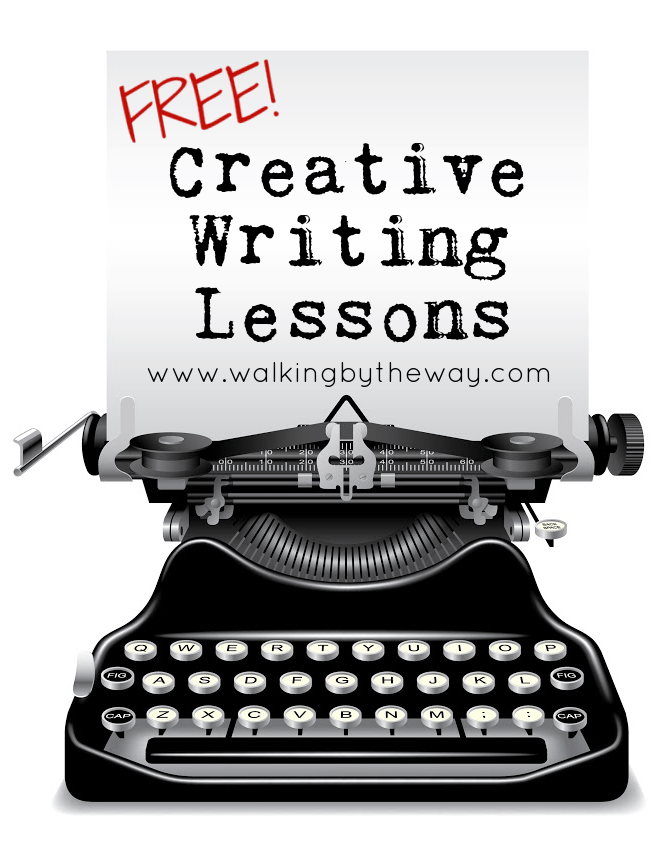
I know I throw around the word favorite all the time. But this is the truth: teaching creative writing lessons is my favorite.
I have taught creative writing enrichment for summer school students. I have taught creative writing in various homeschool settings and co-ops. I have taught big students and little students. And I love it.
Since I love to share homeschool co-op class ideas , I have compiled the creative writing lessons from a co-op class that I taught.
Creative Writing Lessons for a Homeschool Co-op Class
First, please remember that any teacher can use these creative writing lessons. You don’t need to be teaching homeschoolers. You can be a classroom teacher or a homeschool teacher at home with one student. You can even be a librarian who needs a fun program series.
Second, I used these creative writing lesson plans with upper elementary students (with maybe a few 7th graders thrown in). However, you can adapt and use them for older students or younger students!
Creative Writing Lesson Plans
Creative writing lesson one.
The first lesson focuses on cliché and metaphor. It prompts students to consider how words matter.
Grab lesson one here .
Creative Writing Lesson Two
The second lesson teaches students about sensory details: why they are important and how to include them in their writing. Students will begin using sensory details to evoke smells and sounds and sights.
Grab lesson two here.
Creative Writing Lesson Three
The third lesson introduces showing vs. telling. Students learn how to recognize authors who utilize showing, and students are able to articulate the difference between showing and telling.
Grab lesson three here.
Creative Writing Lesson Four
The fourth lesson teaches students how to capture images. We use examples of poetry and prose to discuss this important writing skill.
Grab lesson four here.
Creative Writing Lesson Five
The fifth lesson introduces the story elements of character and conflict.
Note: You may choose to split this lesson into two lessons since it covers two big elements. I only had nine weeks with my students, so I had to jam character and conflict together.
Grab lesson five here.
Creative Writing Lesson Six
The sixth lesson introduces the students to point of view and perspective. We have fun reading poems and using pictures to write descriptions from different points of view.
Grab lesson six here.
Creative Writing Lesson Seven
The seventh lesson puts everything we’ve learned together. I read the students some fractured fairy tales, and we watch some, too. Students then use the prewriting activities and their imaginations to begin drafting their own fractured fairy tales.
Grab lesson seven here.
Creative Writing Lesson Eight
The eighth lesson focuses on revision. After a mini-lesson, students partner up for peer editing.
Grab lesson eight here .
For our final class day, students bring revised work, and I host coffee shop readings. This is a memorable experience for students (and their teacher).
Creative Writing Lessons FAQ
Since posting these creative writing lessons, I have had lots of questions. I decided to compile them here in case you have the same question.
Q: What are copywork quotes? A: Copywork quotes are simply great quotes that students copy as part of their homework assignments. You can use any quotes about writing. I’ve included my favorites throughout the printable packs.
Q: Can I use this with a younger or older student? A: Absolutely! Just adapt it to meet the needs of your student.
Q: Can I use this for my library’s programming or my homeschool co-op class? A: Yes! I just ask that it not be used for profit.
Do you have any questions about teaching creative writing? What’s your biggest hang-up when it comes to teaching creative writing? I’d love to hear from you and help you solve the issue.

January 7, 2016 at 1:57 pm
Hi Theresa,
As long as you are not profitting from using them, they are yours to use! Enjoy! Wish I could be there to help facilitate all those young writers!
[…] Creative Writing Class […]
Leave a Reply Cancel reply
Your email address will not be published. Required fields are marked *
Save my name, email, and website in this browser for the next time I comment.
- International
- Schools directory
- Resources Jobs Schools directory News Search
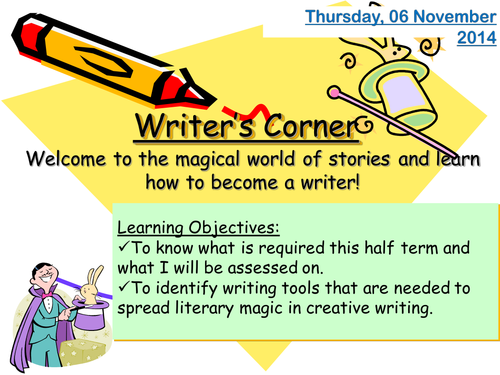
Creative Writing
Subject: English
Age range: 11-14
Resource type: Lesson (complete)
Last updated
20 September 2016
- Share through email
- Share through twitter
- Share through linkedin
- Share through facebook
- Share through pinterest

Creative Commons "Sharealike"
Your rating is required to reflect your happiness.
It's good to leave some feedback.
Something went wrong, please try again later.
Great for less able students.
Empty reply does not make any sense for the end user
Great resources. Thanks for sharing.
Thanks a lot the resources very helpful.
Marvellous and generous resource, which can be adapted for all abilities in junior secondary. Thankyou!
Marianamafemi
Report this resource to let us know if it violates our terms and conditions. Our customer service team will review your report and will be in touch.
Not quite what you were looking for? Search by keyword to find the right resource:

IMAGES
VIDEO
COMMENTS
A Step-by-Step Guide for ParentsStep 1: Creative Writing at Word Level. By year 5, your child will have explored different types of word class, such as verbs (action words), adjectives (describing words) and adverbs (how the action is happening). In lessons, they will be taught to use the most effective word they can in their writing, for ...
Year 5 KS2 English Creative writing learning resources for adults, children, parents and teachers. ... The Regenerators Green Lessons. BBC Teach: KS2 English. Royal Shakespeare Company. External link.
most writing In. · within sections of text some internal structure ·. e.g. one-sentence paragraphs or ideas · loosely organised within paragraphs/sections, some links between sentences, e.g. use of · pronouns or of. adverbials. · movement between paragraphs/sections sometimes disjointed abrupt or. most some writing.
VideosFile previews. pptx, 6.87 MB. pdf, 1.89 MB. A home learning pack designed to promote home learning during school closures, focused on Creative Writing and promoting Literacy skills. The small unit is focused on the video "Ride of Passage" and utilises and expands upon ideas provided on the Literacy Shed.
Inspire your pupils and help them sharpen their creative writing skills with this collection of classroom resources for primary and secondary schools. ... Literacy Live Lesson 5 for 7-11 year-olds.
Year 5 and 6 Creative Writing Morning Activities PowerPoint Week 1. Year 6 Creative Writing: A Step-by-Step Guide for Parents. Year 5 English Grammar and Punctuation Practice Test Pack. UKS2 Uplevelling Sentences Worksheets. 11 Plus Practice Writing Task Activity Mat Pack.
Explore more than 1,690 "Creative Writing Year 5" resources for teachers, parents and pupils as well as related resources on "Year 5 Creative Writing". Instant access to inspirational lesson plans, schemes of work, assessment, interactive activities, resource packs, PowerPoints, teaching ideas at Twinkl!
Guided writing prompt to help your students include writing targets and learn how to structure a paragraph. ... Year 5 creative writing. Subject: English. Age range: 7-11. Resource type: Worksheet/Activity. ... Resources Resources home Early years / Pre-K and Kindergarten Primary / Elementary Middle school Secondary / High school Whole school ...
In Year 5 (age 9-10), your child will work towards being able to: Noting and developing initial ideas, drawing on reading and research where necessary. Using further organisational and presentational devices to structure text and to guide the reader (for example, headings, bullet points, and underlining).
A Step-by-Step Guide for ParentsStep 1: Creative Writing at Word Level. By year 5, your child will have explored different types of word class, such as verbs (action words), adjectives (describing words) and adverbs (how the action is happening). In lessons, they will be taught to use the most effective word they can in their writing, for ...
Group Readers are charmingly illustrated short books written to facilitate reading and comprehension progression from Reception right through to Year 6. Hamilton's Flexible English provides all you need to teach Year 5 SPAG, comprehension or extended writing. Superb resources, from vibrant images to writing templates, grammar exercises and ...
Parents and children will find plenty within this guide to support them as they work on creative writing. Some examples of the help in this guide are: Advice on how children can bring their writing up to a Year 5 level. Various writing activities to help children overcome any nerves they may have. Links to resources which can help make writing ...
We've outlined a seven-step method that will scaffold your students through each phase of the creative process from idea generation through to final edits. 7. Create inspiring and original prompts. Use the following formats to generate prompts that get students inspired: personal memories ("Write about a person who taught you an important ...
KS2 Creative Writing for Yr 4/5/6. Subject: English. Age range: 7-11. Resource type: Lesson (complete) File previews. zip, 3.33 MB. Powerpoint and worksheets for KS2 creative writing lessons. The tasks are designed to help students improve their creative writing. There is a task on developing characters, writing dialogue, describing emotions ...
Explore more than 276 "Creative Writing Prompts Year 5" resources for teachers, parents and pupils as well as related resources on "Creative Writing ". Help. Check out our interactive series of lesson plans, worksheets, PowerPoints and assessment tools today! All teacher-made, aligned with the Australian Curriculum.
First, please remember that any teacher can use these creative writing lessons. You don't need to be teaching homeschoolers. You can be a classroom teacher or a homeschool teacher at home with one student. You can even be a librarian who needs a fun program series. Second, I used these creative writing lesson plans with upper elementary ...
4 x fun and flexible creative writing lessons which will excite even the most reluctant writers; fun activities which guide your pupils through the key elements of narrative writing (descriptive settings, developing characters and structuring a story); creative writing competition linked to the lessons; great poster which illustrates creative-writing principles in a fun & memorable way, which ...
Year 5 narrative writing samples like this have been made with the input of expert Australian educators to make lesson planning a breeze. Because of this, they also fit key areas of the Australian curriculum, including the following content descriptors: Plan, create, edit and publish written and multimodal texts whose purposes may be ...
Here you will find some great creative writing lesson ideas for children. Help young writers find their voice with these fantastic tips, tricks and resources! ... 5 - 6 years old . Year 1 . 6 - 7 years old . Year 2 . 7 - 8 years old . Year 3 . 8 - 9 years old ...
Dive into a spooky-type short story and character analysiswith "The Most Dangerous Game.". "Most Dangerous Game" Character Analysis Workbookfrom Teach BeTween the Lines. MAKER SPACE. This creative lesson to inspire secondary writers is a newer approach. Turn your writer's workshop into a maker spacewith these unique ideas from Spark ...
Search by keyword to find the right resource: Writer's Corner. Magical tools for literary magic. Project based learning. Effective openings. Intriguing characters. Showing not telling. Setting the scene.